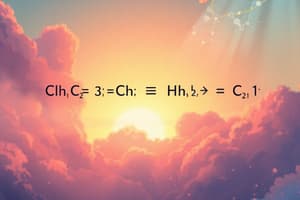Podcast
Questions and Answers
What type of chemical reaction involves breaking complex materials into simpler parts?
What type of chemical reaction involves breaking complex materials into simpler parts?
- Neutralization
- Synthesis
- Combination
- Decomposition (correct)
In a chemical equation, where are the products typically listed?
In a chemical equation, where are the products typically listed?
- On top of the reactants
- Below the reactants
- To the left of the arrow
- To the right of the arrow (correct)
What category of reactions involves merging smaller molecules to form larger ones?
What category of reactions involves merging smaller molecules to form larger ones?
- Displacement
- Dissociation
- Synthesis (correct)
- Neutralization
What is the purpose of coefficients in a balanced chemical equation?
What is the purpose of coefficients in a balanced chemical equation?
Which type of reaction involves one reactant taking the place of another in a compound?
Which type of reaction involves one reactant taking the place of another in a compound?
What is the purpose of coefficients in chemical equations?
What is the purpose of coefficients in chemical equations?
How do catalysts speed up chemical reactions?
How do catalysts speed up chemical reactions?
In a chemical reaction, what does stoichiometry primarily focus on?
In a chemical reaction, what does stoichiometry primarily focus on?
Which term is used to describe the exponents related to the concentrations of substances in a rate law equation?
Which term is used to describe the exponents related to the concentrations of substances in a rate law equation?
Why is understanding rate laws essential for predicting reaction behavior?
Why is understanding rate laws essential for predicting reaction behavior?
Flashcards are hidden until you start studying
Study Notes
Chemical Reactions and Their Components
Chemical reactions involve interactions between elements and compounds, resulting in new substances being formed. These reactions typically lead to the formation of products from reactants through the breaking or formation of chemical bonds between atoms.
Types of Chemical Reactions
Chemical reactions can be divided into several categories based on the nature of the reactants and the products:
- Synthesis: Creating new substances from existing components.
- Decomposition: Breaking complex materials into simpler parts.
- Neutralization: Forming salts when acids meet bases.
- Dissociation: Separating ionic compounds into individual atoms.
- Combination: Merging smaller molecules to form larger ones.
- Displacement: One reactant takes the place of another in a compound, creating a new compound.
Writing Chemical Equations
Balanced chemical equations are crucial for representing the correct amounts of atoms before and after a reaction. Equations contain the following elements:
- Reactants listed to the left of the arrow with coefficients indicating the number of each compound.
- Products listed to the right of the arrow with corresponding coefficients.
- Arrows showing the flow of the reaction.
For example: [ \text{2NO}_2 \rightarrow \text{N}_2 + \text{O}_2 ] represents the decomposition of nitrogen dioxide into nitrogen and oxygen.
Stoichiometry
Stoichiometry refers to the quantitative aspects of chemical reactions, particularly relating to the relative sizes of reactants and products. It ensures that the overall charge remains neutral during a reaction and that mass is conserved according to the law of conservation of matter. Coefficients in chemical equations allow for accurate calculations of the quantities of reactants needed to produce certain amounts of products.
Catalysis
Catalysts speed up chemical reactions without becoming consumed in the reaction. They work by providing alternative pathways with lower activation energies, allowing the reaction to proceed faster. Commonly used catalysts include enzymes, metal compounds, and heterogeneous catalysts found in industrial settings.
Rate Laws and Kinetics
Rate laws govern how fast reactions progress and can be expressed as rate = k[A]^m[B]^n, where k is the rate constant, m and n are exponents related to the concentrations of substances A and B, respectively. Understanding rate laws is essential for predicting the behavior of reactions and optimizing reaction conditions.
Understanding these basic principles of chemical reactions equips scientists and engineers with tools to design and analyze various chemical processes effectively.
Studying That Suits You
Use AI to generate personalized quizzes and flashcards to suit your learning preferences.




